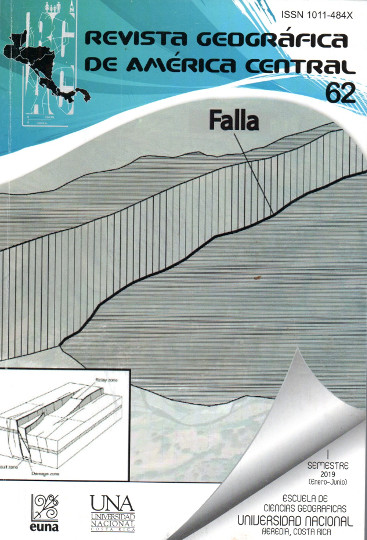Appearance and Diversity of Secondary Forest of Prosopis Caldenia. La Pampa Province, Argentina
DOI:
https://doi.org/10.15359/rgac.62-1.7Keywords:
Endemic, calden forest, protected areas, biodiversityAbstract
The calden forest (Prosopis caldenia) is an endemic vegetation formation of Argentina, mainly distributed in the province of La Pampa. The economic value of the calden wood was one of the reasons why this forest is currently degraded and fragmented. That is why the existence of protected areas to preserve this forest mass is fundamental for its conservation. This work aimed to analyze the appearance and diversity of vegetation in the calden forest, in Luro Park Provincial Reserve, La Pampa province, Argentina. To do this, we applied methodologies of studying vegetation, diversity indices, values of importance and NDVI. The results showed a change of appearance in relation to the pristine forest. It is recognized that the shrubby stratum acquired greater coverage, although the calden continues to be the species with the highest value of importance in the forest.
References
Albera, H. (2002). Bosque de caldén en la provincia de La Pampa. Gobierno de la Provincia de Córdoba. 1ra Reunión Nacional para la Conservación de la Caldenia Argentina. Córdoba, Argentina: Agencia Córdoba. (pp. 31-39).
Bogino, S. M. (2006). El bosque de caldén en la provincia de San Luis: situación actual y estrategias alternativas de manejo. En: Kairós, Revista de Temas Sociales, 17, 1-7.
Benlloch, I. y Yetano, M. (1989). El estudio de la vegetación en Geografía. En: Geographicalia, 26, 165-174.
Bosque Pampeano. (2015). El bosque en Parque Luro. Recuperado de http://www.bosquepampeano.org/index.php/planes/novedades/342-el-bosque-en-parque-luro
Cabrera, A. (1976). Regiones fitogeográficas argentinas. Tomo II. Enciclopedia argentina de agricultura y jardinería. Buenos Aires, Argentina: Acme. (pp. 1-90).
Cámara, R. y Díaz del Olmo, F. (2013). Muestreo en transecto de formaciones vegetales de fanerófitos y caméfitos (I): fundamentos metodológicos. En: Estudios Geográficos, 74(274), 67-88.
Cisneros, J. M., Nuñez, C., Cantero, O., Degioanni, J., Plevich, A., Cabido, O., Petryna, L. y Amuchastegui, A. (2002). Caldenia cordobesa: Una síntesis florística y ambiental. En: Primera Reunión para la conservación de la Caldenia Argentina. Córdoba, Argentina: Agencia Córdoba. (pp. 18-20).
Dussart E., Chirino, C., Morici, E. y Peinetti, R. H. (2011). Reconstrucción del paisaje del caldenal pampeano en los últimos 250 años. Quebracho, 19(1,2) 54-65.
Lell, J. D. (2005). El caldenal: una visión panorámica del mismo enfatizando en su uso. En: Ecología y manejo de los bosques de Argentina. (pp. 1-18). La Plata, Argentina: Editorial de la Universidad Nacional de La Plata.
Lencinas J. D., Chauchard, L. y Grosfeld, J. (2006). Primer inventario nacional de bosques nativos segunda etapa. Inventario de campo de la región espinal distritos caldén y ñandubay. Buenos Aires, Argentina: Secretaría de Ambiente y Desarrollo Sustentable de la Nación.
Lerner, P. (2005). El caldenal: dinámica de poblaciones de caldén y procesos de expansión de leñosas en pastizales. Ecología y manejo de los bosques de Argentina. La Plata, Argentina: Editorial de la Universidad Nacional de La Plata. (pp. 1-15).
Lewis J. P., Prado, D. E. y Barberis, I. (2004). Los remanentes de bosques del Espinal en el este de la provincia de Córdoba. La situación ambiental Argentina 2005. (pp. 254-260).
Medina, A. (2007). Reconstrucción de los regímenes de fuego en un bosque de Prosopis caldenia, provincia de La Pampa, Argentina. En: Bosque, 28(3) 234-240.
Medina, A. (2008). Cicatrices de fuego en el leño de Prosopis caldenia en Luán Toro, provincia de La Pampa, Argentina. En: Bosque, 29(2), 115-119.
Moreno, C. (2001). Métodos para medir la biodiversidad. Zaragoza, España: La Sociedad Entomológica Aragonesa.
Sala, M. y Batalla, R. (1996). Teoría y métodos en Geografía Física. Madrid, España: Síntesis.
Zinda, R., Adema, E. y Rucci, T. (2005). Relevamiento fisonómico de la vegetación del área del caldenal. Instituto Nacional de Tecnología Agropecuaria Angüil. Recuperado de: https://inta.gob.ar/sites/default/files/script-tmp-publi60.pdf
Downloads
Published
How to Cite
Issue
Section
License
Proposed policy for journals offering Open Access
Authors publishing their works in the Journal acknowledge and agree to the following terms:
a) Authors retain the copyrights to their works and guarantee the Journal the right to be the first to publish their works, under the Creative Commons License Attribution-NonCommercial-ShareAlike 4.0 International, CC BY-NC-SA 4.0 International (https://creativecommons.org/licenses/by-nc-sa/4.0/deed.es), which allows others to share works upon complying with the acknowledgment of authorship and mention of the Journal as the original publisher of the work.
b) Authors are permitted to separately establish additional agreements for the non-exclusive distribution of the official edition of the work published in the Journal (for example, authors may desire to place the work in an institutional repository or incorporate it into a book that is to published elsewhere) so long they acknowledgment to recognize the Journal as the original publisher. The aforementioned additional agreements must respect the terms of the non-profit character and sharing philosophy of the original license (CC BY-NC-SA 4.0 International, https://creativecommons.org/licenses/by-nc-sa/4.0/deed.es).
c) Authors are encouraged to archive the post-print or editor/PDF version in Open Access repositories.






 REVGEO is licensed under https://creativecommons.org/licenses/by-nc-sa/4.0/deed.es
REVGEO is licensed under https://creativecommons.org/licenses/by-nc-sa/4.0/deed.es
.svg_4.png)

_(1).png)
_(1)_(1)_(1)_1.png)
(2)(1)(1)(1).png)
